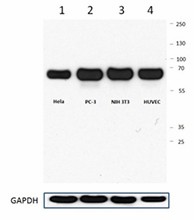- Clone
- 1351 (See other available formats)
- Regulatory Status
- RUO
- Other Names
- Dystrophin-associated protein A1 acidic component 1, Pro-TGF-alpha cytoplasmic domain-interacting protein 1, TACIP1, Syntrophin-1, SNT1, LQT12,dJ1187J4.5
- Isotype
- Mouse IgG1, κ

-

Western blot showing human and mouse reactivity with clone 1351, which was tested on 15 µg/lane of HeLa, PC-3, 3T3, and HUVEC lysates and was tested at 1 µg/ml. The blot was incubated with HRP anti-mouse IgG secondary antibody and GAPDH antibody was used as a positive control.
| Cat # | Size | Price | Quantity Check Availability | ||
|---|---|---|---|---|---|
| 845102 | 100 µg | $335.00 | |||
Syntrophins are a family of five 60 kD adapter proteins that use their multiple protein interaction domains (two PHDs and a PDZ) to localize various signaling proteins (kinases, ion/water channels, or NOS) to specific intracellular locations. In neurons, syntrophins are known as the postsynaptic density protein (PSD) that serves to connect neurotransmitter receptors (such as nAChRs) to the cytoskeleton.
Product Details
- Verified Reactivity
- Human, Mouse, Rat
- Antibody Type
- Monoclonal
- Host Species
- Mouse
- Immunogen
- Whole purified syntrophin from Torpedo californica electric organ postsynaptic membrane.
- Formulation
- Phosphate-buffered solution, pH 7.2, containing 0.09% sodium azide.
- Preparation
- The antibody was purified by affinity chromatography.
- Concentration
- 0.5 mg/ml
- Storage & Handling
- The antibody solution should be stored undiluted between 2°C and 8°C.
- Application
-
WB - Quality tested
ICFC, ICC, IHC-F, IP - Reported in the literature, not verified in house - Recommended Usage
-
Each lot of this antibody is quality control tested by Western blotting. For Western blotting, the suggested use of this reagent is 1.0 - 5.0 µg per ml. It is recommended that the reagent be titrated for optimal performance for each application.
- Application Notes
-
The epitope has been mapped to amino acids 108-120 within the a-syntrophin PDZ domain.
-
Application References
(PubMed link indicates BioLegend citation) -
- Froehner S, et al. 1987. J. Cell Biol. 104:1633. (WB, IHC)
- Gee S, et al. 1998. J. Neurosci. 18:128. (IP)
- Ort T, et al. 2001. EMBO 20:4013. (IP, WB)
- Adams M, et al. 2001. J. Cell Biol. 155:113. (IF)
- Williams M, et al. 1999. J. Cell Biol. 144:1259. (IHC)
- Product Citations
-
- RRID
-
AB_2566133 (BioLegend Cat. No. 845102)
Antigen Details
- Structure
- Monomer and homodimer. Syntrophins consist of a conserved domain, two pleckstin homology domains, a PDZ domain, and a highly conserved C-terminal syntrophin unique (SU) domain. Expected MW: 58 kD.
- Function
- Adapter protein that binds to and probably organizes the subcellular localization of a variety of membrane proteins. May link various receptors to the actin cytoskeleton and the dystrophin glycoprotein complex.
- Interaction
- Interacts with the other members of the syntrophin family SNTB1 and SNTB2; SGCG and SGCA of the dystrophin glycoprotein complex; NOS1; GRB2; the sodium channel proteins SCN4A and SCN5A; F-actin and calmodulin; Interacts with MYOC.
- Biology Area
- Cell Biology, Neuroscience, Signal Transduction, Synaptic Biology
- Molecular Family
- Postsynaptic proteins
- Gene ID
- 6640 View all products for this Gene ID
- UniProt
- View information about Syntrophin on UniProt.org
Other Formats
View All Syntrophin Reagents Request Custom Conjugation| Description | Clone | Applications |
|---|---|---|
| Purified anti-Syntrophin | 1351 | WB,ICFC,ICC,IHC-F,IP |
| Ultra-LEAF™ Purified anti-Syntrophin | 1351 | WB |
Compare Data Across All Formats
This data display is provided for general comparisons between formats.
Your actual data may vary due to variations in samples, target cells, instruments and their settings, staining conditions, and other factors.
If you need assistance with selecting the best format contact our expert technical support team.
-
Purified anti-Syntrophin

Western blot showing human and mouse reactivity with clone 1... -
Ultra-LEAF™ Purified anti-Syntrophin

Western blot showing human and mouse reactivity with clone 1...
